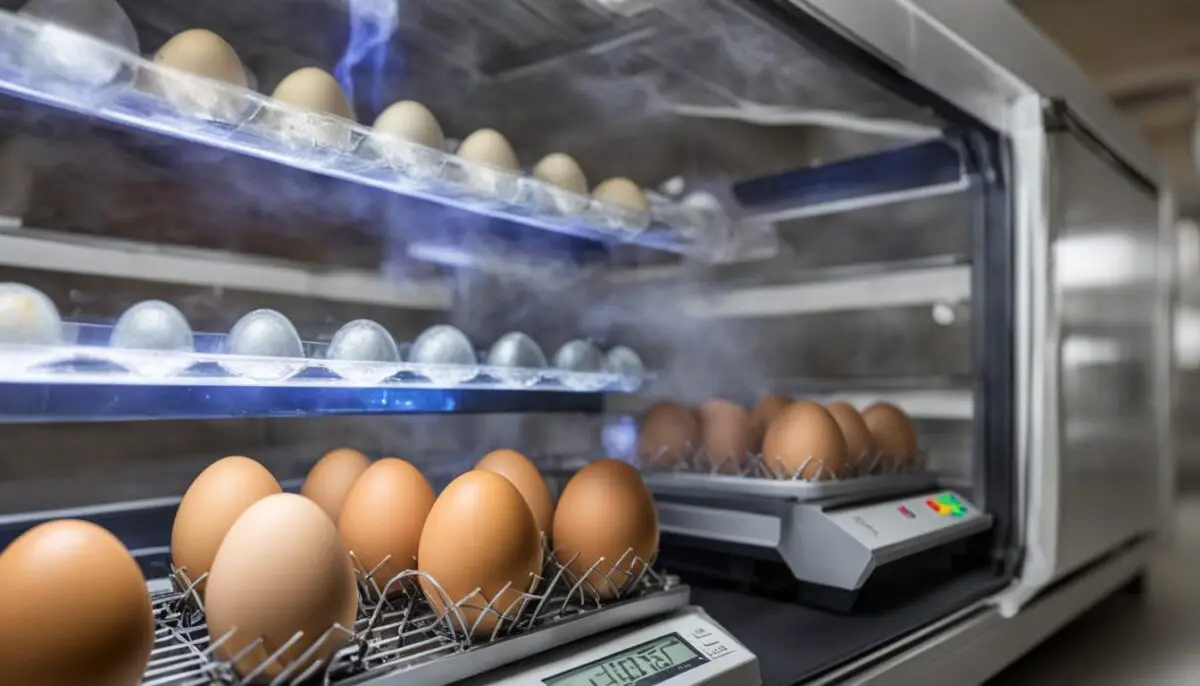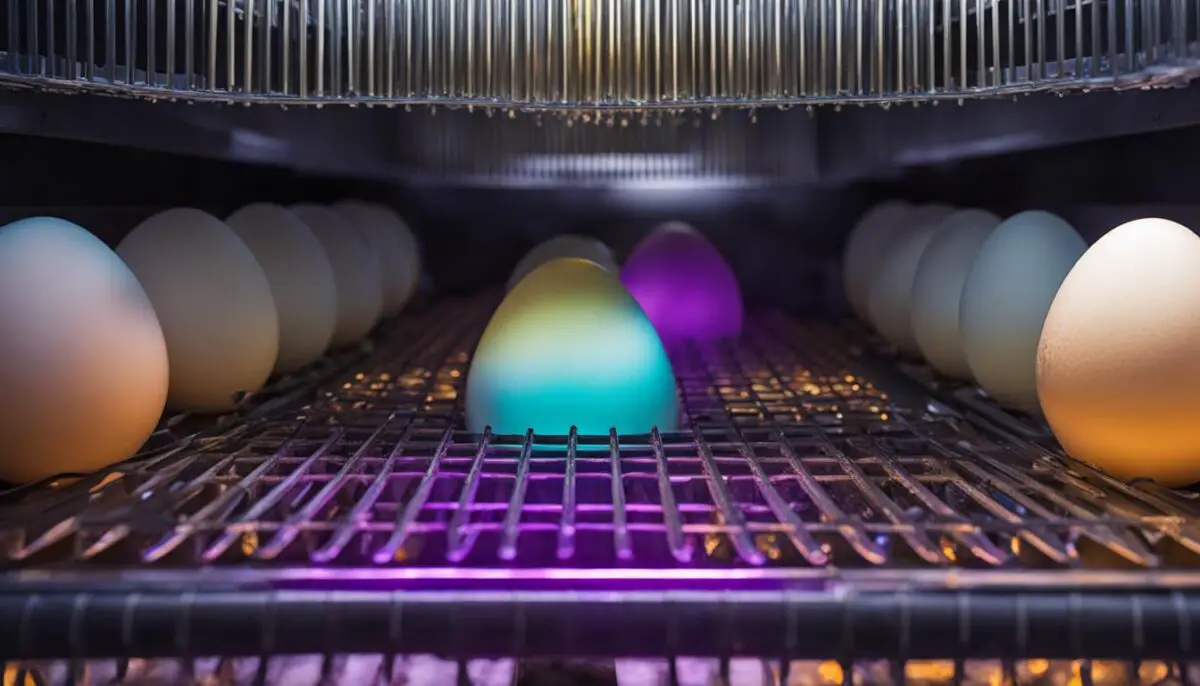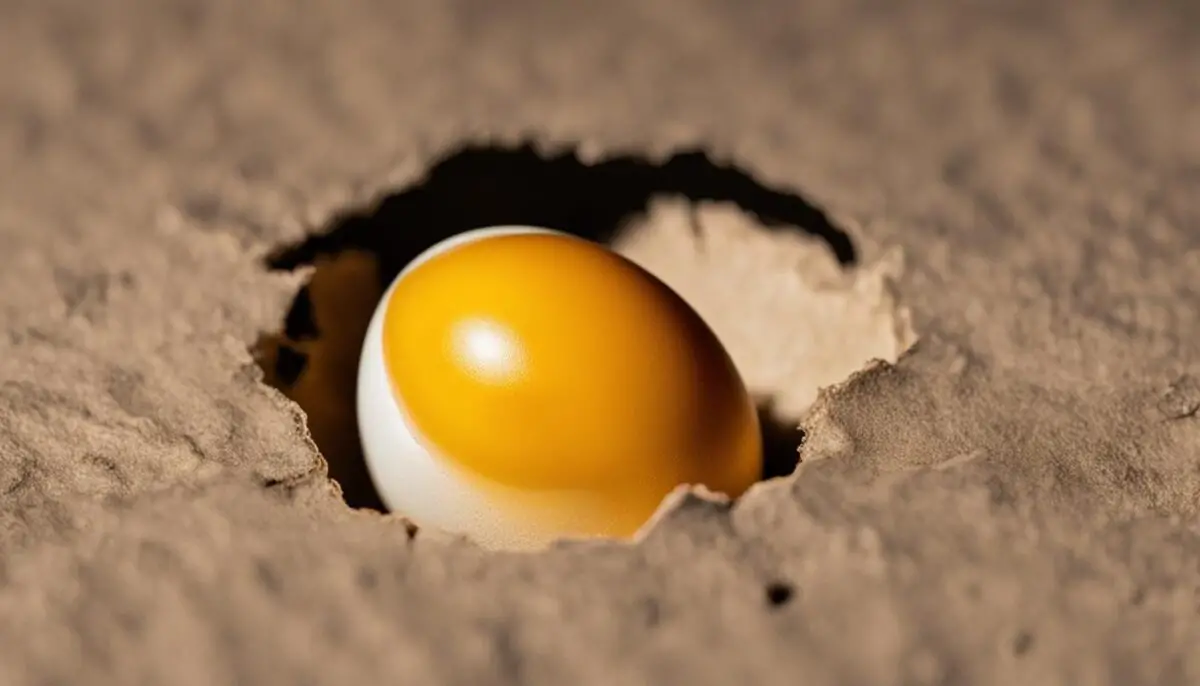Hatching chicken eggs is a delicate process that requires careful consideration of various factors, including temperature. The optimal incubation temperature for chicken eggs plays a crucial role in ensuring successful hatch rates. In this article, we will explore the importance of maintaining the right temperature for hatching chicken eggs and provide guidance on achieving optimal conditions for a successful hatch.
Key Takeaways:
- Optimal incubation temperature for chicken eggs is around 100.5 degrees Fahrenheit.
- Maintaining a temperature range of 99-102 degrees Fahrenheit is crucial for successful hatch rates.
- Eggs sold in grocery stores are not fertile and will not hatch.
- Fertile eggs should be obtained from NPIP-certified flocks.
- Consistency in temperature is essential throughout the incubation period.
Preparing for Incubation
Prior to incubating chicken eggs, it is necessary to secure fertile eggs from hens that have been housed with a rooster. These eggs should be stored in a cool room at a constant temperature of 55-60 degrees Fahrenheit for up to 7 days. It is important to stock up on chick starter feed before the eggs hatch, as newly hatched chicks will need immediate access to complete feed. The choice of chick starter feed will depend on flock goals and whether the chicks have been vaccinated for coccidiosis.
| Fertile Eggs | Chick Starter Feed |
|---|---|
| Secure from hens housed with a rooster | Stock up before eggs hatch |
| Store at 55-60°F for up to 7 days | Provide immediate access to complete feed |
| Choice depends on flock goals and vaccination status |
Securing Fertile Eggs
Before starting the incubation process, it is important to obtain fertile eggs from hens that have had access to a rooster. The rooster’s presence is necessary for fertilization to occur. By ensuring that the eggs are sourced from hens that have mated with a rooster, you can increase the chances of successful hatching.
Storing Fertile Eggs
Once the fertile eggs are secured, they should be stored in a cool room with a constant temperature of 55-60 degrees Fahrenheit. This temperature range helps maintain the viability of the eggs during the storage period. It is important not to expose the eggs to extreme temperatures or fluctuations, as this can negatively impact their hatchability.
Importance of Chick Starter Feed
Chick starter feed is a crucial nutritional source for newly hatched chicks. It provides essential nutrients, vitamins, and minerals necessary for their growth and development. It is recommended to stock up on chick starter feed before the eggs hatch to ensure that the chicks have immediate access to complete feed as soon as they hatch.
Choosing the Right Chick Starter Feed
The choice of chick starter feed will depend on your flock goals and whether the chicks have been vaccinated for coccidiosis. Different varieties of chick starter feed are available, ranging from medicated to non-medicated options. Consult with a poultry nutritionist or veterinarian to select the most suitable feed for your specific flock requirements.

| Days | Temperature | Humidity |
|---|---|---|
| 1-17 | 100.5°F | 50-55% |
| 18-21 | 100.5°F | 70% |
Setting the Eggs and Turning
Once the incubator is set up, it is time to place the fertile eggs in the egg tray. Make sure to position the eggs with the larger end facing up. Setting a minimum of six eggs at a time is recommended to optimize the hatch rate and increase the chances of successful hatching.
Turning the eggs is a critical step in the incubation process. This process prevents the developing chick from sticking to the inside surface of the shell. It is recommended to turn the eggs a minimum of three times per day, preferably five times, to ensure proper development.
If you are using an automatic incubator, the egg turning process can be handled automatically. However, if you have a manual incubator, you may need to mark the eggs to keep track of which ones have been turned.
Remember, hygiene is essential when handling eggs. Wash your hands thoroughly or wear clean gloves before touching the eggs to prevent contamination.
Benefits of Egg Turning
Turning the eggs during incubation helps optimize the chances of successful hatching. Here are some key benefits:
- Prevents deformities: Regularly turning the eggs ensures proper blood circulation to the developing embryo, preventing deformities and promoting healthy growth.
- Enhances nutrient distribution: Turning the eggs helps distribute the nutrients evenly, ensuring the embryo receives essential nutrition for development.
- Strengthens chick muscles: The constant movement resulting from egg turning promotes muscle development in the growing chick, improving overall hatch rate and chick strength.
So, don’t forget to turn your eggs regularly and ensure the best possible environment for successful hatch rates!

| Egg Turning Schedule | Number of Turns Per Day |
|---|---|
| Minimum | 3 |
| Preferred | 5 |
Candling Eggs
Candling eggs is an essential process during the incubation period to assess the development of the embryos. By shining a light through the egg, you can determine if the embryo is progressing as expected. This procedure is typically performed around 7-10 days into the incubation period.
During candling, infertile eggs will appear clear, indicating that no embryo is present. On the other hand, eggs with a developing embryo will show visible signs of blood vessels and movement inside. This confirms that the egg is fertile and on track for hatching.
If you come across broken or leaking eggs during candling, it is recommended to remove them from the incubator. These eggs are unlikely to hatch and can potentially impact the surrounding eggs’ development.
When candling eggs, it is best to work in small batches to minimize the time the eggs are outside the controlled environment of the incubator. This ensures that the temperature and humidity levels remain stable for the eggs’ optimal development.

Incubation Timeline
| Incubation Days | Temperature | Humidity | Actions |
|---|---|---|---|
| 1-17 | 99-102°F (37.2-38.9°C) | 50-55% | Regularly turn the eggs |
| 18 | 70% humidity | 70% | Stop turning the eggs |
| 19-21 | 99-102°F (37.2-38.9°C) | 70% | Wait for chicks to hatch |
| After hatch | 95°F (35°C) | Varies with age | Move chicks to a brooder |
Effects of Temperature on Embryo Development
The temperature during incubation is vital for the proper development of chicken embryos. The optimal incubation temperature for chicken eggs is around 100.5 degrees Fahrenheit. This temperature allows for the optimal embryonic metabolism and development.
Elevated temperatures can have detrimental effects on the development of the embryo, leading to heat injury and lower hatchability rates. On the other hand, lower temperatures can slow down the development process and result in increased mortalities. Therefore, maintaining a consistent temperature within the recommended range is crucial for achieving successful hatch rates.
Table: Effects of Temperature on Embryo Development
| Temperature | Effect |
|---|---|
| High Temperatures (Above 102°F) | Increase the risk of heat injury and decrease hatchability rates |
| Optimal Temperature (100.5°F) | Promote proper embryonic metabolism and development |
| Low Temperatures (Below 99°F) | Slow down development and increase mortalities |
By carefully controlling the temperature during incubation, poultry farmers can provide the ideal conditions for optimal embryo development, leading to higher hatch rates and healthier chicks.
Conclusion
Controlling temperature during chicken egg incubation is essential for achieving successful hatch rates. Research has shown that the optimal incubation temperature for chicken eggs is around 100.5 degrees Fahrenheit, with a temperature range of 99-102 degrees Fahrenheit. Maintaining a consistent temperature within this range is crucial for embryonic development and hatchability.
In addition to temperature, proper humidity levels and egg turning are also important factors in ensuring a successful hatch. Monitoring and maintaining optimal humidity levels between 50-55% during the first 17 days and increasing to 70% on days 18-21 can significantly increase hatch rates. Egg turning is equally important as it helps prevent the developing chick from sticking to the inside surface of the shell.
Adhering to recommended incubation temperature guidelines and closely monitoring the incubator are crucial for successful hatch rates. By providing the ideal environment for the developing chicks, with a consistent temperature, proper humidity levels, and regular egg turning, you can increase the chances of a successful hatch and the healthy development of your chicks.
FAQ
What is the optimal temperature for incubating chicken eggs?
The optimal incubation temperature for chicken eggs is around 100.5 degrees Fahrenheit.
What is the temperature range for incubating chicken eggs?
The temperature range for incubating chicken eggs is 99-102 degrees Fahrenheit.
Why is maintaining a consistent temperature important during egg incubation?
Maintaining a consistent temperature is crucial for successful hatch rates as it ensures proper embryo development.
Where should I obtain fertile eggs for incubation?
Fertile eggs should be obtained from NPIP-certified flocks, where hens have been housed with a rooster.
How should fertile eggs be stored prior to incubation?
Fertile eggs should be stored in a cool room at a constant temperature of 55-60 degrees Fahrenheit for up to 7 days.
What should I stock up on before the eggs hatch?
It is important to stock up on chick starter feed, as newly hatched chicks will need immediate access to complete feed.
What features should an egg incubator have?
An egg incubator should have automatic features such as egg turning and a fan for even heat distribution.
What is the recommended temperature for incubating chicken eggs?
The recommended temperature for incubating chicken eggs is 100.5 degrees Fahrenheit.
How often should I turn the eggs during incubation?
Eggs should be turned a minimum of 3 times per day, preferably 5 times, to prevent the developing chick from sticking to the inside surface of the shell.
What is candling eggs and when should I do it?
Candling eggs is a process of shining a light through the egg to determine if the embryo is developing properly. It is usually done around 7-10 days into the incubation period.
When should I stop turning the eggs?
Eggs should no longer be turned starting from day 18 of the incubation period.
What should I do if I find broken or leaking eggs?
Broken or leaking eggs should be removed from the incubator as they are unlikely to hatch.
How should I prepare for hatching?
On day 18, the incubation temperature should be increased to 70% humidity. The eggs should no longer be turned.
What should I do if the chicks don’t hatch on day 21?
It is not uncommon for chicks to take a few more days to hatch. Let the chicks hatch on their own and avoid premature assistance, as it can cause harm.
What temperature should the incubator be set to after hatching?
After hatching, the incubator temperature can be lowered to 95 degrees Fahrenheit.
What temperature should the brooder be set to for the newly hatched chicks?
The brooder temperature should be set to 90-95 degrees Fahrenheit for the newly hatched chicks.
What effects does temperature have on the development of chicken embryos?
Temperature plays a critical role in embryo development, with higher temperatures leading to heat injury and lower hatchability, while lower temperatures can slow down development and increase mortalities.
Are eggs sold in grocery stores fertile?
No, eggs sold in grocery stores are not fertile and will not hatch. Fertile eggs should be obtained from NPIP-certified flocks.

